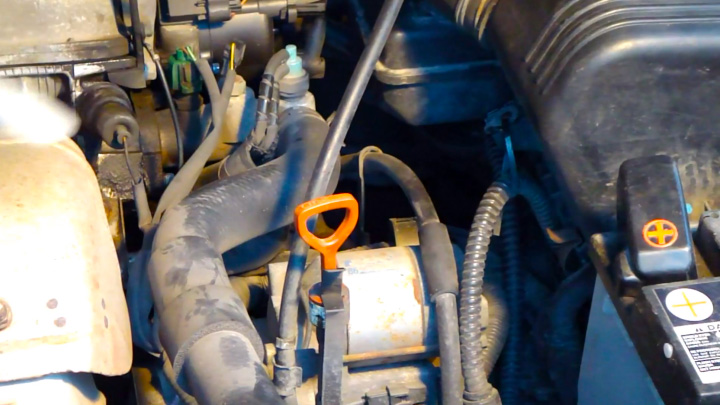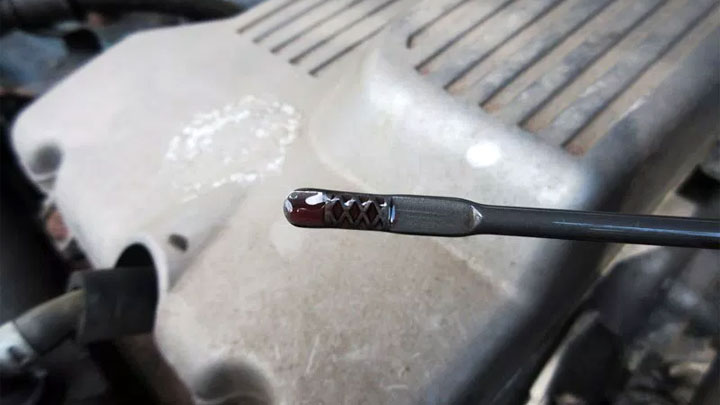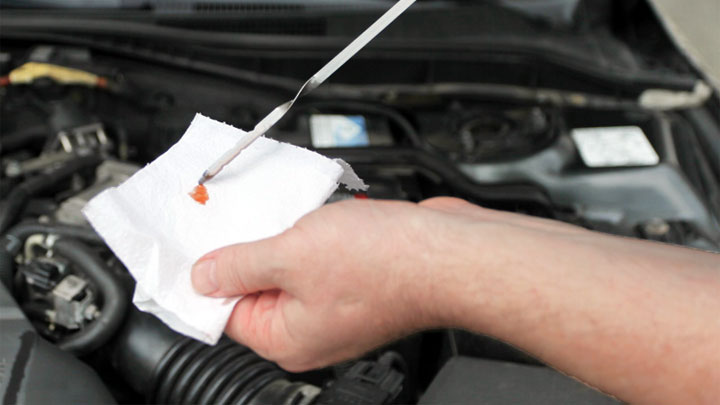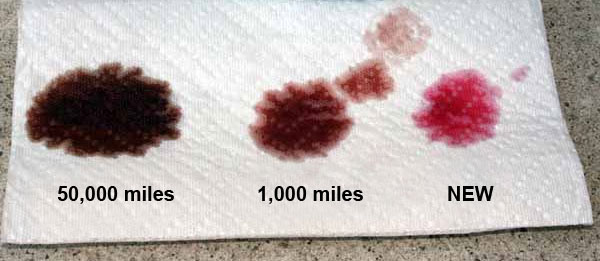How to Check and Add Transmission Fluid (Automatic and Manual)
No matter what type of transmission you have, regular transmission fluid checks should be part of your maintenance routine.
- The bad news… one type of transmission makes the process much more difficult.
- The good news… you likely don’t have that transmission.
Keep reading to learn step-by-step how to check your transmission fluid, how often to do so, and what specific thinks you should be looking for in the fluid itself.

Checking Automatic Transmission Fluid
The majority of car manufacturers will tell you to replace your automatic transmission fluid anywhere from 100,000 to 150,000 miles. If you aren’t sure, check your owner’s manual to see the exact recommendation from your vehicle’s manufacturer.
However, if you were to ask 10 professional mechanics how often to change your transmission fluid, the majority would likely tell you the transmission fluid change interval should be much sooner.
Either way, you should regularly inspect the level (and condition) of transmission fluid that you have. If you have a dipstick and filler tube in your transmission, you can inspect the fluid level yourself. Otherwise, have a mechanic inspect your transmission fluid for you.
Here are a few helpful tips to investigate the condition of your automatic transmission fluid:
Check Fluid Level

Always check the fluid level first. When using the dipstick, see if the fluid level of the automatic transmission falls between the “add” and “full” labels. If it does, then the fluid level is normal. But if the level is on “add” or below it, then the fluid level is too low and needs to be replaced.
A low fluid level will cause the transmission to be much slower in its engagement. On the other hand, if the fluid level is too high, then air will start to mix with it and cause all kinds of problems with shifting. You will notice a lot of sounds and slippage too.
If the transmission is overheated, then this is another reason to check the transmission fluid level. Just put it in the park position and let the engine remain idle. Change gears to every position available before proceeding to check the fluid level. This will provide a reading that is much more precise.
Related: What is a “Normal” Transmission Temperature?
Check Fluid Condition

Transmission fluid that looks foamy or contains lots of bubbles is likely the result of too much fluid in the automatic transmission. This could also be due to having a transmission vent that is plugged or merely using the wrong type of fluid in there.
Transmission fluid that looks brownish could be the result of a contamination problem with the coolant. The radiator may be leaking from its fluid oil cooler which is responsible for mixing the transmission fluid with the coolant. Fix this problem right away if you notice it.
Related: 3 Symptoms of Burnt Transmission Fluid
Check Fluid Color

You could test for fluid oxidation by merely sniffing or doing a blotter test. Take a clean paper towel and place a couple of drops of automatic transmission fluid onto it. After about 30 seconds, see what color the fluid is and whether it has spread out.
If it has spread out and looks light brown, pink or red, then it is in good condition. If it has not spread and has a very dark brown color, then it means there is fluid oxidation. Therefore, change or flush the fluid right away.
Related: Average Cost to Change Transmission Fluid
How to Add Automatic Transmission Fluid

If you have checked the fluid level in your vehicle’s transmission and found it to be low, fluid must be added. Follow these steps:
- Using your owner’s manual determine the correct automatic transmission fluid your vehicle requires.
- Purchase several quarts of this specific fluid. Unused fluid can be saved for future use. Or if unused containers have not been opened, you should be able to return them to your parts store for a refund.
- Check the transmission fluid following the procedure specified for your car. Your owners manual should guide you in this regard. See ‘Check Automatic Transmission Fluid’ above.
- If the fluid level is low, the transmission dipstick will not indicate how much to add. You do not want to overfill the transmission. So begin by adding ½ quart of fluid.
- Repeat Step 3 above. If the dipstick shows the transmission is now full, the job is done. Wipe the dipstick clean and reinstall it.
- If more oil is required, add a sparing amount again and repeat the checking procedure. Repeat this process until the oil level reaches the full mark.
Note: Some newer cars no longer provide a dipstick for checking and adding automatic transmission fluid. If this is the case for your vehicle, you will need your dealer or favorite mechanic to periodically check the fluid level and add fluid as necessary.
Check Manual Transmission Fluid

Manual transmission fluid (gear oil) helps lubricate and cool down the manual transmission. Anytime you have problems shifting your vehicle or you hear grinding sounds while changing gears, you should see if your transmission fluid is at the level it’s supposed to be at.
It is good to know how to check these fluid levels regardless of whether you’ve had problems with it. The fluid levels should be checked on a regular basis so that you can prevent your transmission from getting damaged in case the fluid does go bad or gets low.
A dipstick would help you check the manual transmission fluid levels but unfortunately, most manual transmission vehicles don’t have one. This means you must take off the filler plug and check the level of fluid yourself.
On the side of the transmission, you can unscrew the filler plug which is located there. Although, some transmissions have the filler plug located on the top instead. If necessary, use a jack or ramp of some kind to lift the transmission and find the filler plug so you can access it.
Below the filler, you should see the transmission fluid and a hole to check the level of fluid. Just put your finger in the hole to do this, as long as the owner’s manual for the vehicle states that it’s okay to do that.
While you observe the level of fluid in there, take notice of its color and the smell. If the color is dark or has a burning smell to it, then it needs to be replaced. There should also be no metal pieces in there either.
How to Add Manual Transmission Fluid
If you have checked the fluid level in your vehicle’s manual transmission and found it to be low, fluid must be added. Follow these steps:
- Using your owner’s manual determine the correct fluid (gear oil) your vehicle requires.
- Purchase several quarts of this specific oil. Unused oil can be saved for future use. Or if unused containers have not been opened, you should be able to return them to your parts store for a refund.
- You will also need a transmission fluid hand pump. These are available at your parts store. The pump will fit into the fluid container and be screwed in place. It will include a length of plastic tubing which can be inserted into the transmission fill port for adding oil.
- Gear oil will get thick and more viscous when cold. Under cold conditions it can be difficult to pump with the hand pump you purchased. Store your gear oil cans inside your home until you are ready to add oil to your manual transmission. Or warm them prior to opening them in a bucket of hot water.
- Check the transmission gear oil level following the procedure specified for your car. See ‘Check Manual Transmission Fluid’ above. It is unlikely that this procedure will be described in your owner’s manual. A shop manual for your specific car could prove helpful for this and many other service procedures.
- Install the pump into the gear oil container. Place the end of the plastic tubing into the transmission fill port. Press the pump plunger repeatedly adding fluid to the transmission until it reaches the level of the fill port.
- Remove the plastic tube from the fill port. Wipe the fill plug clean and reinstall it into the fill port. Tighten snugly.
- Replace the Engine or Replace the Car? (11 Factors to Consider) - Apr 11, 2024
- Plastic Piece Dragging Under Your Car? (What It Is and What To Do) - Mar 21, 2024
- Timing Belt vs Timing Chain (What’s the Difference?) - Feb 27, 2024

Hello Mark,
Excellent article !
However here are a few questions to clear out some ambiguities:
1. What is the ATF operating temparature range in which ATF level is supposed to be measured?
2. In the blotter test, does the red spot lose color and become transparent eventually when left to dry?
3. Does ATF go bad with time even if the car is used sparingly? This question arises from the fact that recommended ATF intervals different from manufacturer to manufacturer, even though their cars are using the same transmission and same spec ATF ! Some even skip the time based ATF change interval and only recommend milage based intervals.
Please share your thoughts.
1. When the engine is warmed up that’s usually a good time to check the transmission fluid.
2. I don’t know about completely transparent, but certainly easier to see through than dirty fluid.
3. ATF is designed to last quite a while, and I wouldn’t worry too much about it going bad over time compared to engine oil. It is also fairly well sealed up inside the transmission. In fact, some transmissions are completely sealed and the ATF is considered a “lifetime fluid” where there is no service interval specified by the manufacturer. To me, this means the ATF in those vehicles lasts 100k miles; even though they say you never need to change it, I still would. How long are we talking about leaving the ATF in the car?